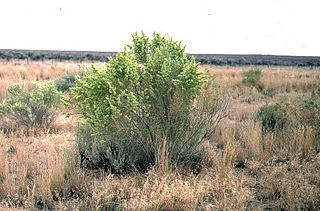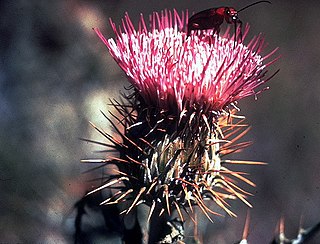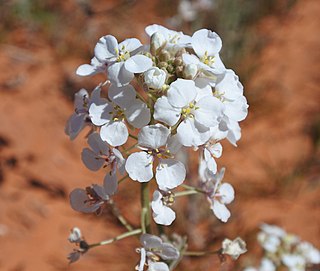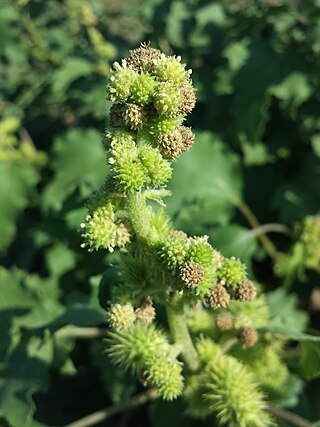This is a list of plants and how they are used in Zuni culture.
This is a list of plants and how they are used in Zuni culture.

Rumex crispus, the curly dock, curled dock or yellow dock, is a perennial flowering plant in the family Polygonaceae, native to Europe and Western Asia.

Atriplex canescens is a species of evergreen shrub in the family Amaranthaceae native to the western and midwestern United States.

Juniperus monosperma is a species of juniper native to western North America, in the United States in Arizona, New Mexico, southern Colorado, western Oklahoma (Panhandle), and western Texas, and in Mexico in the extreme north of Chihuahua. It grows at 970–2300 m altitude.

Lithospermum incisum is a species of flowering plant in the borage family known by several common names, including fringed puccoon, narrowleaf stoneseed, fringed gromwell, narrowleaf puccoon, and plains stoneseed. It is native to much of central Canada and the United States, where it is known from many types of habitat, but particularly piñon-juniper woodland. It is a hairy perennial herb growing from a narrow brown to black taproot and woody caudex. It produces a cluster of stems up to about 30 centimeters long. The stems are lined with narrow, pointed leaves up to 6 centimeters long. The slender, trumpet-shaped flowers are pale to bright yellow or gold, and may approach 4 centimeters long. The corolla face is 1 to 2 centimeters wide, its lobes sometimes ruffled. The smaller cleistogamous (closed) flowers are the main producers of seed.

Dysphania atriplicifolia is species of flowering plant known by the common names winged pigweed, tumble ringwing, plains tumbleweed, and tumble-weed. This plant is native to central North America, but it is spreading and has been occasionally reported in far-flung areas from California to Maine to the Canadian prairie. It is considered an introduced species outside of central North America. This is a bushy annual herb forming a rounded pale green clump which may exceed 0.5 m in height. It is very intricately branched, with toothed leaves occurring near the base. The spreading stems bear widely spaced flowers are small immature fruits fringed with a nearly transparent membranous wing. In autumn, the plant forms a tumbleweed. The fruit is a utricle about 2 millimeters long containing a single seed.

Hymenopappus filifolius is a North American species of flowering plant in the daisy family known by the common names fineleaf hymenopappus and Columbia cutleaf. It is native to western and central North America from Alberta and Saskatchewan south as far as Chihuahua and Baja California.

Eriogonum jamesii is a species of wild buckwheat known by the common name James' buckwheat and antelope sage. It is native to the southwestern United States, being found in: Colorado, Utah, Arizona, Texas, New Mexico, Oklahoma, and Nebraska.

Atriplex argentea is a species of saltbush known by the common names silverscale saltbush and silver orache. It is native to western North America from southern Canada to northern Mexico, where it grows in many types of habitat, generally on saline soils.

Cirsium ochrocentrum is a species of thistle known by the common name yellowspine thistle. It is native to the Great Plains of the Central United States and to the desert regions of the western United States and northern Mexico. Its range extends from eastern Oregon east to the Black Hills of South Dakota, south as far as the Mexican State of Durango.
Abronia fragrans, the sweet sand-verbena, snowball sand-verbena, prairie snowball or fragrant verbena, is a species of sand verbena.

Dimorphocarpa wislizeni, commonly known as spectacle pod, Wislizeni's spectaclepod, and touristplant, is a flowering plant in the mustard family native to western North America, where it occurs in the southwestern United States as far east as Oklahoma and Texas, and Baja California, Sonora, Chihuahua, and Coahuila in Mexico.

Mirabilis multiflora is a species of flowering plant in the four o'clock family known by the common names Colorado four-o'clock or desert four-o'clock that is native to the southwestern United States from California to Colorado and Texas, as well as far northern Mexico, where it grows in mostly dry habitat types in a number of regions.
This is a list of plants used by the indigenous people of North America. For lists pertaining specifically to the Cherokee, Iroquois, Navajo, and Zuni, see Cherokee ethnobotany, Iroquois ethnobotany, Navajo ethnobotany, and Zuni ethnobotany.
See also Zuni ethnobotany, and Native American ethnobotany.

Croton texensis, commonly known as Texas croton, goat weed, skunk weed, and doveweed, is a species of plant found in the United States.

Eriogonum alatum, with the common names winged buckwheat and winged eriogonum, is a species of buckwheat.

Hymenoxys richardsonii, the pingue hymenoxys or pingue rubberweed, is a North American species of plants in the sunflower family. It is widespread across the western United States and western Canada from Arizona, New Mexico, and western Texas north as far as Alberta and Saskatchewan.
This is a list of plants documented to have been traditionally used by the Cherokee, and how they are used.
The Iroquois use a wide variety of medicinal plants, including quinine, chamomile, ipecac, and a form of penicillin.

Xanthium orientale is a species of annual plant of the daisy family Asteraceae.